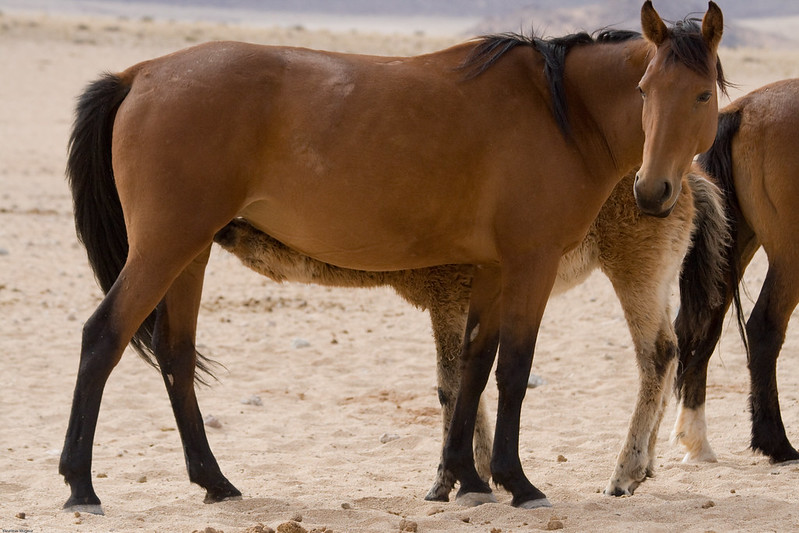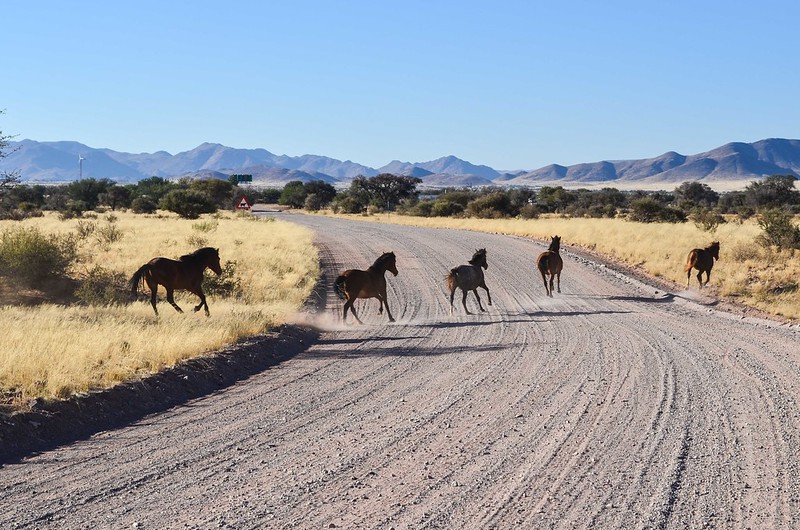Namib Desert Horse — are wild horses that can be found in Namibia's, Namib Desert. The only African feral horse herd, it has a population of between 90-150. The Namib Desert Horse looks athletic and is often dark in colour. It probably descends from European light-riding horses. The horses, despite the harsh environment they live in, are usually in good health, except for extreme drought. Numerous population studies have been conducted on horses, providing valuable insight into their ability to survive in the desert and their population dynamics.
 |
| Desert horses |
Desert Horse
Several theories have been proposed, but it is still unclear where the Namib desert horse came from. Although genetic tests have been conducted, none have yet to prove their origin. Most likely, the horses' ancestors are a mixture of cavalry and riding horses. Many of these horses were bred from German breeding programs. Near Aus in Namibia, the plains of Garub the horses are eventually settled, where they get water supplied by humans. They were mostly ignored by humans until the 1980s when they were threatened with extinction. This was because of the possibility that their native herbivore habitat was being destroyed. The first aerial population survey was conducted in 1984. Some of these African wild horses were removed from the herd at various times, including the sale and removal of more than one-third in 1992. In the 1990s, records of the population were kept and studies were conducted to assess the effect of horses on the environment. They are considered exotic animals within the park but they can be kept because of their historical connections to the country and their popularity as a tourist attraction.
Although the most common Namib Desert horse colour is bay, there are also a few brown and chestnut horses. Although there are fewer black horses, these are rare. Many individuals have dorsal stripes but no zebra stripes. There are no other colours. Namib Desert horses have strong bones and are muscular, athletic, muscular, and clean-limbed. They have a short back and oblique shoulders. They also have good withers. They have the look of well-bred riding these African horses in terms of their head, skin, coat, and appearance. Foals can sometimes have club hooves, which is likely because of trauma to their hoofs while travelling long distances.
Image / Source
 |
| Wild horses in Africa |
Image / Source
Namib Desert Horse
Desert horse breeds — The home distance of the Namib Desert Horse runs from the Namib desert to the Coichab River, which is usually dry, and west to the Great Escarpment. Although there may be as many as two horses, bands of horses can range in size and consist of several animals. Between 1993 and 2003, six to eleven bands of horses were observed. These included breeding groups, bachelor herds, and co-operating groups with more than one horse that share the breeding duties. The Namib Desert horse travels extensively in search of food, water, and shelter from the weather and insects. The average home area of the Namib Desert Horse is 13 square miles (34km2) according to a 1994 study. However, not all of this distance is covered each day. Between the few water sources and the best grazing resources, they must travel considerable distances. This puts a lot of pressure on the population and makes it difficult to select weaker animals.
Wild horses in Africa
Horse like animals in Africa — Namib Desert horses Africa is one of the most isolated horse populations in the world after the genetic testing revealed in 2001. They also have the second-lowest level of genetic variation among all the horse populations studied. This is partly due to the small population that was established and the shrinking population during droughts. Despite the large domesticated breeding stock from which horses are descended, there has been at least one genetic bottleneck in the history of the breed, resulting in a substantial decline in genetic variation in a short time. While a minimum population for genetic variability is 200 horses, this number cannot be sustained given the current rainfall. The minimum population required to preserve genetic effectiveness is between 100 and 150 animals.
 |
| Namib desert horse |
Image / Source
Wild Horse Desert
 |
| African wild horses |
Image / Source
 |
| African horses |
Image / Source
 |
| Horses Africa |
Image / Source
 |
| Horses in Africa |
Image / Source
 |
| Horse like animals in Africa |
Image / Source
 |
| Desert horse breeds |
Image / Source
 |
| African horse breeds |
Image / Source
 |
| Namibia wild horses |
Image / Source
The Wild Horses in Namib Desert Google Map
The Wild Desert Horses of Aus, Namibia — Video
 |
| Desert horse |
Image / Source
Source / Wikipedia

No comments:
Post a Comment